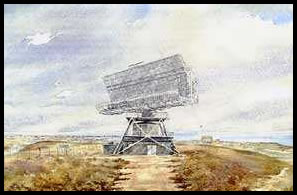Anyone who heard the interview on R4 this morning with a former Radar worker may’ve had some old memories sparked.
If you did, prepare for more, as we are very pleased to have had contact with a former RAF member – Don Adams – who has agreed to put together his account of the previous life of the Radar Station up on St Boniface Downs.
The seemingly lifeless National Air Traffic Site at the top of St. Boniface may be well known to all Ventnorians, but fifty years ago the scene up there was very different. It was the home of an Early Warning Radar Station and the area was dominated by a huge rotating radar and three weird looking nodding height finding radars.

A small grey bungalow concealed the entrance to a deep and massive underground bunker the walls, roof and floor of which were made of ten feet thick reinforced concrete. Down there, working in shifts, members of the RAF kept a constant watch for suspicious aircraft up to 300 miles away, for in those Cold War years there was a very real threat from our perceived enemy. On-call fighter aircraft could be guided to such intruders and indeed there were regular such incidents, though not in Ventnor’s area of coverage.

Most of the RAF radar operators and technical personnel were still teenagers, serving their period of compulsory National Service. No “gap” years in those days! In all they numbered about a hundred and were housed in brick built huts at the Domestic Site situated at the end of Lowtherville Road : part of Chestnut Close now replaces the hut in which I once lived.
At any one time, a third of these young men would be working and another third would be sleeping. The remainder would be out in search of amusement. In summer one spent much time on the beach eying up “the talent”, but in the evenings perhaps after a round of putting at Flowersbrook, the long gone Prince of Wales was generally the pub of choice. Or else The Hole in the Wall, where the speciality was Merrydown cider, a glass of which was the same price as a pint of beer, but far more potent.
The Rose was another port of call and the evening usually wound up at The Coconut Grove, a coffee bar attached to The Metropole Hotel on the front almost opposite the pier. The popular Saturday evening venue was of course The Winter Gardens for ballroom dancing, the perfect place in which to meet girls, both holiday makers and the local variety.

Many brief attachments were formed and some long lasting ones – 50 years so far for me. I wonder how many Island girls were carried off by those boys in blue over the period of twenty one years that the RAF presence existed?
Some lads dissipated their energies in other ways. Quite a few played football or rugby for both the RAF teams and for the Ventnor clubs. One friend of the writer became the Island Cross Country champion in 1958.
Others attended local churches and some performed in the local operatic society. All in all it is believed that a very amicable integration existed between the RAF and the local populace.
My time at Ventnor proved to be the most significant turning point in my life and I’ve written at greater length about those days on my website at and also about his similarly modest adventures at home and abroad during his three years of service in the RAF.
It is fashionable to mock or decry National Service, but this honest and sometimes humorous account, which in no way promotes military training, may give any curious member of the current younger generation a better idea of the harsh finishing school endured by all young men in those distant days. I welcome email contact from anyone associated with RAF Ventnor, the address being found on my website.
[Radar images courtesy of Ventnor Radar][Winter Gardens image courtesy of Isle of Wight Historic Postcards]


